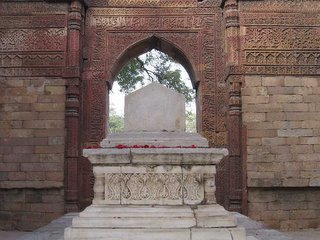The parking at the site was inadequate and a chaotic mess. The entry fee of Rs 10/- for Indian citizens is nominal. As is the case with most other sights in India, the entry fee for foriegners is considerably higher at $5 or Rs 250/-. This is a trend that keeps me wondering - India would perhaps be one of the rare nations to extort (or should we say penalise) visitors for wishing to view its treasures.
The first thing that struck us as we entered the compound was the rush. Having shown little interest ourselves in this piece of history so far, we were least prepared to see the crowds thronging the place. But there they were - a number of groups, with families or friends, some enjoying the sight of the structures, others basking in the warm sunlight in the lush green lawns.
The sight that greeted us was that of a majestic Minar, standing tall into the bright blue sky, towering above a few other relics of the bygone era. At the immediate left was the Alai Darwaza. To the further left, and towards the right were passageways with carved pillars supporting their roofs.
Alai Darwaza is a magnificient gateway with walls of carved stone, arched gates on all four sides and a tall roof with a dome, a very typical structure of the mughal architecture.
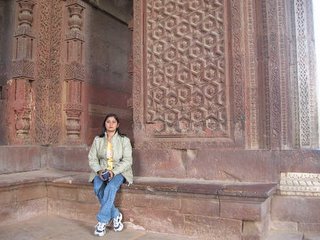 As we entered the Alai darwaza, through the left archway, we could see the tomb of Imam Zamim. It is small, but beautiful. Unfortunately, and according to me, sinfully, the interiors of the tomb have been vandalized by some of the visitors.
As we entered the Alai darwaza, through the left archway, we could see the tomb of Imam Zamim. It is small, but beautiful. Unfortunately, and according to me, sinfully, the interiors of the tomb have been vandalized by some of the visitors.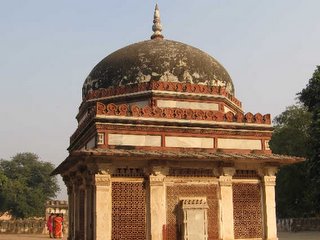 Exiting from the opposite archway, we saw the outside wall (which was constructed as the actual entrance to the minar) of Alai Darwaza, adorned with carved stone pieces.
Exiting from the opposite archway, we saw the outside wall (which was constructed as the actual entrance to the minar) of Alai Darwaza, adorned with carved stone pieces.
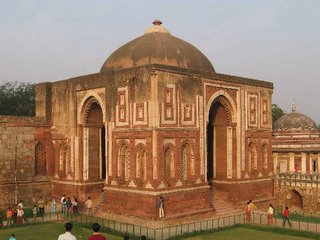 From this vantage point, we got to see the Qutub Minar in the glow of the afternoon sun. As we strolled in the Qutub complex, we were fascinated by the ruins of the buildings and gateways. We captured the Qutub Minar from different angles.
From this vantage point, we got to see the Qutub Minar in the glow of the afternoon sun. As we strolled in the Qutub complex, we were fascinated by the ruins of the buildings and gateways. We captured the Qutub Minar from different angles.


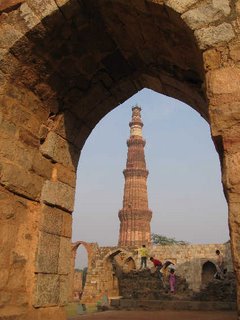
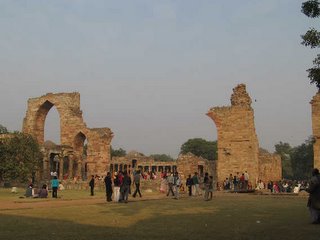


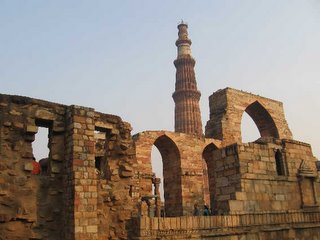 To the northeast of Minar is the Quwwat-ul-Islam Mosque, which consists of a rectangular courtyard, enclosed by cloisters supported by intricately carved pillars.
To the northeast of Minar is the Quwwat-ul-Islam Mosque, which consists of a rectangular courtyard, enclosed by cloisters supported by intricately carved pillars.

 As we looked closely, we were surprised to see traditional hindu designs on the pillars and the walls. We could also see on the walls, an impression of the idols seen in hindu and jain temples, though with disfigured faces. On one piece we could also make out an eroded image of Ganesha.We were excited by our "discovery" and made a guess that this mosque must have been built by demolishing an old temple. It was only later we learnt the reason of presence of hindu architecture in this mosque was that the mosque had been constructed using columns and structures from 27 hindu and jain temples demolished by Qutbu'd-Din Aibak.
As we looked closely, we were surprised to see traditional hindu designs on the pillars and the walls. We could also see on the walls, an impression of the idols seen in hindu and jain temples, though with disfigured faces. On one piece we could also make out an eroded image of Ganesha.We were excited by our "discovery" and made a guess that this mosque must have been built by demolishing an old temple. It was only later we learnt the reason of presence of hindu architecture in this mosque was that the mosque had been constructed using columns and structures from 27 hindu and jain temples demolished by Qutbu'd-Din Aibak.
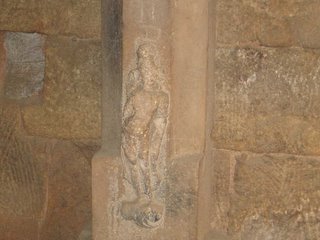
 Also in the complex is the tomb of Iltutmish, a square chamber with beautifully carved stone on the entrance as well as in the interior.
Also in the complex is the tomb of Iltutmish, a square chamber with beautifully carved stone on the entrance as well as in the interior.
Walking in the complex, we could see more buildings (or probably, ruins) of ancient times nearby. Although these were once a part of the Qutub complex, they are now outside the complex wall and not accessible to visitors of Qutub.

